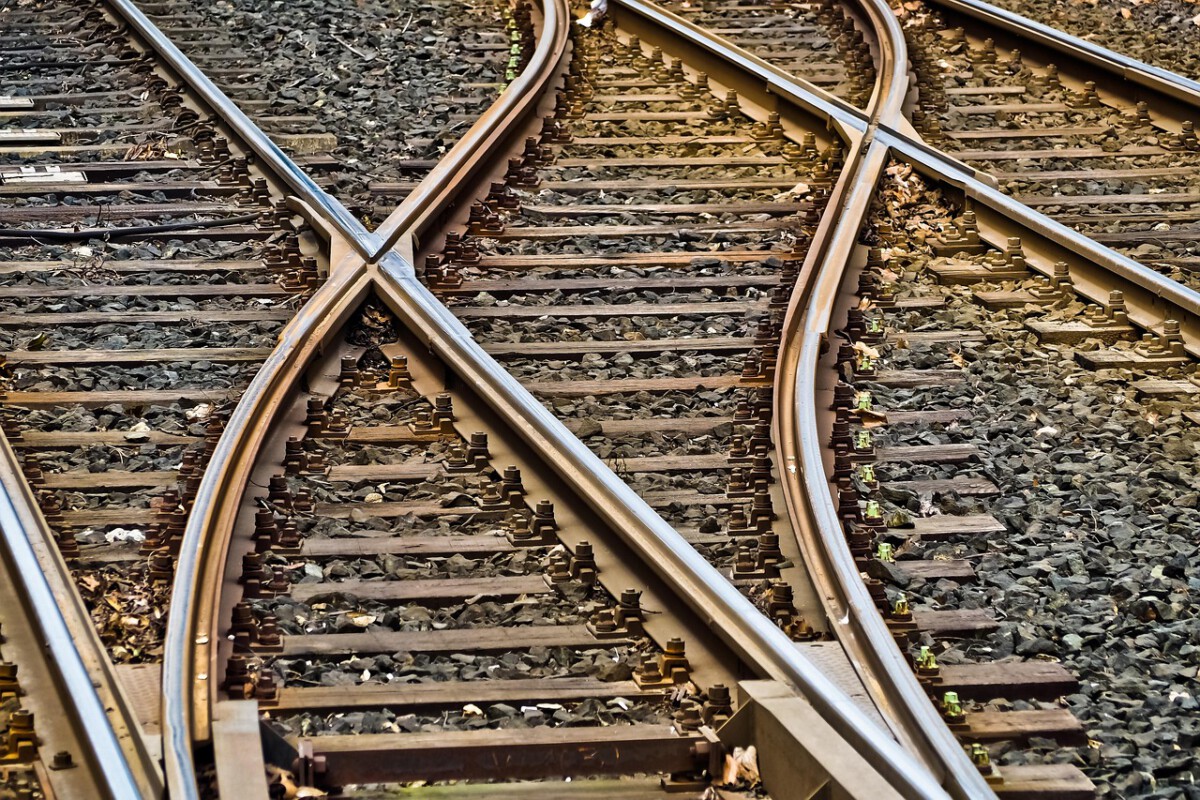The Great Vision Takes Shape

The possibility of railroads connecting the Atlantic and Pacific coasts was discussed in the Congress even before the treaty with England which settled the question of the Oregon boundary in 1846. Chief promoter of a transcontinental railroad was Asa Whitney, a New York merchant active in the China trade who was obsessed with the idea of a railroad to the Pacific. In January 1845 he petitioned Congress for a charter and grant of a sixty-mile strip through the public domain to help finance construction. In 1853, U.S. Secretary of War Jefferson Davis commissioned the Pacific Railroad Surveys to “ascertain the most practical and economical route for a railroad from the Mississippi River to the Pacific Ocean.” Under the direction of Brevet Captain George B. McClellan, the U.S Army Corps of Topographical Engineers surveyed potential routes.
Civil War Opens the Door

When the South seceded from the Union at the beginning of the American Civil War, they could no longer lobby for a transcontinental route through the southern United States. In 1862, Congress settled on a route between St. Louis, MO, and Sacramento, CA, and passed the Pacific Railroad Act guaranteeing public land grants and loans to the Union Pacific and Central Pacific Railroads to build the transcontinental line. On July 1, 1862, well into the second year of the Civil War, President Abraham Lincoln signed the Pacific Railroad Act of 1862. While amid a country divided, the Pacific Railroad Act of 1862 opened the idea of a railroad that ran from the Missouri River to the Pacific Ocean. Under the Act, the Union government chartered the Central Pacific and Union Pacific Railroad companies to construct this colossal rail line.
The Stakes Were Enormous

The federal government promised both companies three types of bonds for different types of track laid down. For track laid down on level land, the federal government promised each company $16,000 per mile, or about $461,000 today. And lastly, the federal government would pay each company $48,000 for each mile of track laid in mountains, or about $1,383,000 today. Congress granted the railroad companies 6,400 acres of government-owned lands for every ten miles of track laid to help create maintenance yards and sidings.
The amount of land that the two companies received from the federal government equated to about the size of Texas. Between state and federal government land grants, the two companies owned about 180,000,000 acres of land by the end of construction.
Racing Against Time and Nature

Thus started a competition between the two companies to see who could lay as much railroad track down as possible. The first rails were spiked in January of 1863. However, the bulk of the construction of the Transcontinental Railroad would not truly start until after the end of the Civil War. The Central Pacific Railroad Company moved slowly through the Sierra Nevada Mountains. The company suffered tremendously with worker retention due to how brutal the labor was. To get through the Sierra Nevada’s, the Central Pacific built massive trestle bridges and blasted through the mountains with gunpowder and nitroglycerine.
The Chinese Workers’ Sacrifice

Charles Crocker of the Central Pacific decided to hire Chinese laborers, approximately 50,000, to work on the Transcontinental Railroad. The Chinese laborers proved to the Central Pacific that they were tireless workers. As many as 20,000 may have worked on the railway. The death toll was staggering, estimated in the thousands. It is estimated that about 1 in 10 Chinese laborers working on the Sierra Nevada leg of the transcontinental railroad died from inter-racial violence, rockslides, explosions, environmental exposure, violence and even avalanches.
Chinese workers, though compensated for their work, were still paid about $10-15 less than their White counterparts. Working conditions were incredibly dangerous and workers were offered no protections. Paid less than their white counterparts and working under dangerous conditions, on June 25, 1867, Chinese laborers staged a strike demanding equal pay, shorter workdays, and better working conditions. The strike lasted about a week and only stopped when the Central Pacific Railroad company stopped feeding the workers and threatened the lives of the remaining strikers.
Breaking Through the Mountains

Despite transportation delays, the Central Pacific’s Chinese laborers—more than 80 percent of its workforce—ascended the Sierra Nevada Mountains and reached Donner Pass (elevation 7,057 feet) in August 1867 and Reno, NV, in June 1868. In the final year of construction, Central Pacific crews lay approximately 560 miles of track between Reno, NV, and Promontory Summit, UT, including a single-day record of more than 10 miles of track on April 28, 1869. By the summer of 1867, the Union Pacific was in Wyoming, having covered nearly four times as much ground as the Central Pacific. The Central Pacific broke through the mountains in late June, however, and the hard part was finally behind them.
The Final Push

In early 1869, the two companies were within four miles from one another. Newly elected President and former Civil War General Ulysses S. Grant explained to the two companies that the federal government would withhold funding if they could not come up with a meeting point. Hastily, the two companies decided that they would meet at Promontory Summit, just north of the Great Salt Lake in Utah. Both companies then headed towards Salt Lake City, cutting many corners (including building shoddy bridges or sections of track that would have to be rebuilt later) in their race to get ahead.
The Golden Spike Ceremony

On May 10, 1869, Central Pacific Railroad President Leland Stanford used a silver hammer to drive a ceremonial golden rail spike that completed the 1,912-mile-long Central Pacific and Union Pacific Railroads’ tracks at Promontory Summit, UT. The ceremony marked the opening of the United States’ first transcontinental railroad. On May 10, 1869, at 12:47 p.m., the final spike was driven into the last bit of track. Called the “Golden Spike Ceremony”, the last spike linked the two railroads to create a transcontinental railroad.
Travel Time Revolution

The 6-year construction project opened huge swaths of the United States to settlement and reduced the average travel time between New York City, NY, and San Francisco, CA, from months in 1860 to just 7 days by 1870. The round trip that took Lewis and Clark two-and-a-half years in 1803 was now a nine-day journey. The consequences of this new technology were profound. In the 1860s, a six-month stagecoach trip across the U.S. cost $1,000 (about $20,000 in today’s dollars), according to the University of Houston’s Digital History website.
Economic Transformation

By 1880, the transcontinental railroad was transporting $50 million worth of freight each year. In addition to transporting western food crops and raw materials to East Coast markets and manufactured goods from East Coast cities to the West Coast, the railroad also facilitated international trade. “The Constitution provided the legal framework for a single national market for trade goods; the transcontinental railroad provided the physical framework,” explains Henry W. Brands, a history professor at the University of Texas at Austin, and author of Dreams of El Dorado: A History of the American West. “Together they gave the United States the single largest market in the world, which provided the basis for the rapid expansion of American industry and agriculture to the point where the U.S. by the 1890s had the most powerful economy on the planet.”
Opening the West

By 1900, much of the nation’s railroad system was in place. The railroad opened the way for the settlement of the West, provided new economic opportunities, stimulated the development of town and communities, and generally tied the country together. With the completion of its great railroad, America gave birth to a transcontinental culture. And the route further engendered another profound change in the American mind. Here was manifest destiny wrought in iron; here were two coasts united; here was an interior open to settlement. Distances shrank, but identification to land and fellow American grew in inverse proportion.
The Human Cost

A Disaster for Native Americans Not everyone would benefit from that transformation. The transcontinental railroad was not the beginning of white settlers’ battles with Native Americans. Nor was it the final nail in the coffin. But it was an irrevocable marker of encroaching white society, that unstoppable force which would force Indians onto reservations within decades. And the buffalo herds upon which Indians depended had been nearly depleted. They were easy prey to sport-hunters brought to the plains by the carload.
For years following the completion of the first transcontinental railroad, the survivors often journeyed back to the Sierra to search for the human remains of lost colleagues (called jup seen you or retrieving dead friends). For those who survived, railroad construction allowed immigrants to gain steady employment and create careers in early American railroad companies.
A Lasting Legacy

Railroads may no longer be the fastest way for passengers to cross the United States, but they continue to play an indispensable role in our nation’s economy. In March 2023, the Bureau of Labor Statistics estimated that the nation’s railroads employed approximately 149,400 people. These employees of the nation’s seven Class I railroads (railroads with operating revenues of $490 million or more), 22 regional, and hundreds of local/short line railroads move around 1.7 billion tons of freight over 140,000 miles of track annually, according to the Association of American Railroads.
In the two decades after Promontory Summit railway mileage of the country blossomed by nearly 250 percent, to 161,000 miles in 1889 from 47,000 in 1869. In 1882, Chinese crews completed the second transcontinental railroad, the Southern Pacific, which connected Texas cattle and cotton to California and markets in Asia.
Conclusion

The Transcontinental Railroad stands as one of America’s greatest achievements, a testament to human determination and engineering prowess. Built at enormous cost in both money and lives, it transformed a fragmented nation into a unified continent-spanning powerhouse. “What the transcontinental railroad did was bring the West into the world, and the world into the West,” explains James P. Ronda, a retired University of Tulsa history professor and co-author, with Carlos Arnaldo Schwantes, of The West the Railroads Made. In particular, it helped turn California from a once-isolated place to a major economic and political force and helped lead to the state’s rapid growth.
Yet this achievement came at a staggering human cost, particularly for Chinese workers who built the western portion and Native Americans whose lands were seized. The railroad’s legacy remains complex — it united the nation economically and culturally while simultaneously dividing it socially and racially. Its iron rails carried more than goods and people; they carried the dreams, ambitions, and contradictions of a young nation rushing toward its destiny.






